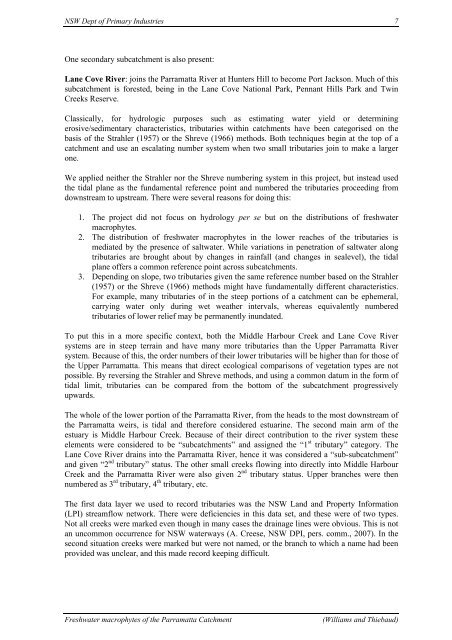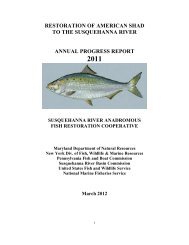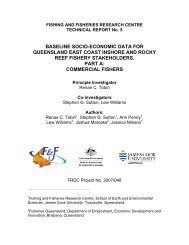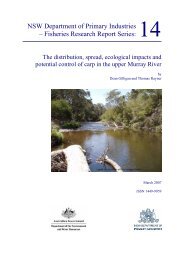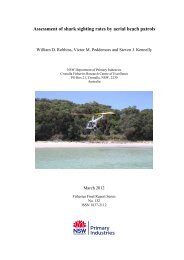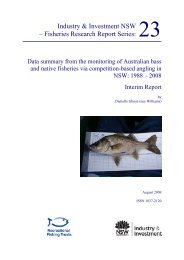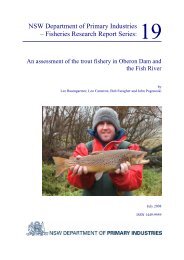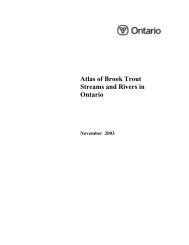The freshwater macrophytes of - Fisheries Reports
The freshwater macrophytes of - Fisheries Reports
The freshwater macrophytes of - Fisheries Reports
Create successful ePaper yourself
Turn your PDF publications into a flip-book with our unique Google optimized e-Paper software.
NSW Dept <strong>of</strong> Primary Industries 7<br />
One secondary subcatchment is also present:<br />
Lane Cove River: joins the Parramatta River at Hunters Hill to become Port Jackson. Much <strong>of</strong> this<br />
subcatchment is forested, being in the Lane Cove National Park, Pennant Hills Park and Twin<br />
Creeks Reserve.<br />
Classically, for hydrologic purposes such as estimating water yield or determining<br />
erosive/sedimentary characteristics, tributaries within catchments have been categorised on the<br />
basis <strong>of</strong> the Strahler (1957) or the Shreve (1966) methods. Both techniques begin at the top <strong>of</strong> a<br />
catchment and use an escalating number system when two small tributaries join to make a larger<br />
one.<br />
We applied neither the Strahler nor the Shreve numbering system in this project, but instead used<br />
the tidal plane as the fundamental reference point and numbered the tributaries proceeding from<br />
downstream to upstream. <strong>The</strong>re were several reasons for doing this:<br />
1. <strong>The</strong> project did not focus on hydrology per se but on the distributions <strong>of</strong> <strong>freshwater</strong><br />
<strong>macrophytes</strong>.<br />
2. <strong>The</strong> distribution <strong>of</strong> <strong>freshwater</strong> <strong>macrophytes</strong> in the lower reaches <strong>of</strong> the tributaries is<br />
mediated by the presence <strong>of</strong> saltwater. While variations in penetration <strong>of</strong> saltwater along<br />
tributaries are brought about by changes in rainfall (and changes in sealevel), the tidal<br />
plane <strong>of</strong>fers a common reference point across subcatchments.<br />
3. Depending on slope, two tributaries given the same reference number based on the Strahler<br />
(1957) or the Shreve (1966) methods might have fundamentally different characteristics.<br />
For example, many tributaries <strong>of</strong> in the steep portions <strong>of</strong> a catchment can be ephemeral,<br />
carrying water only during wet weather intervals, whereas equivalently numbered<br />
tributaries <strong>of</strong> lower relief may be permanently inundated.<br />
To put this in a more specific context, both the Middle Harbour Creek and Lane Cove River<br />
systems are in steep terrain and have many more tributaries than the Upper Parramatta River<br />
system. Because <strong>of</strong> this, the order numbers <strong>of</strong> their lower tributaries will be higher than for those <strong>of</strong><br />
the Upper Parramatta. This means that direct ecological comparisons <strong>of</strong> vegetation types are not<br />
possible. By reversing the Strahler and Shreve methods, and using a common datum in the form <strong>of</strong><br />
tidal limit, tributaries can be compared from the bottom <strong>of</strong> the subcatchment progressively<br />
upwards.<br />
<strong>The</strong> whole <strong>of</strong> the lower portion <strong>of</strong> the Parramatta River, from the heads to the most downstream <strong>of</strong><br />
the Parramatta weirs, is tidal and therefore considered estuarine. <strong>The</strong> second main arm <strong>of</strong> the<br />
estuary is Middle Harbour Creek. Because <strong>of</strong> their direct contribution to the river system these<br />
elements were considered to be “subcatchments” and assigned the “1 st tributary” category. <strong>The</strong><br />
Lane Cove River drains into the Parramatta River, hence it was considered a “sub-subcatchment”<br />
and given “2 nd tributary” status. <strong>The</strong> other small creeks flowing into directly into Middle Harbour<br />
Creek and the Parramatta River were also given 2 nd tributary status. Upper branches were then<br />
numbered as 3 rd tributary, 4 th tributary, etc.<br />
<strong>The</strong> first data layer we used to record tributaries was the NSW Land and Property Information<br />
(LPI) streamflow network. <strong>The</strong>re were deficiencies in this data set, and these were <strong>of</strong> two types.<br />
Not all creeks were marked even though in many cases the drainage lines were obvious. This is not<br />
an uncommon occurrence for NSW waterways (A. Creese, NSW DPI, pers. comm., 2007). In the<br />
second situation creeks were marked but were not named, or the branch to which a name had been<br />
provided was unclear, and this made record keeping difficult.<br />
Freshwater <strong>macrophytes</strong> <strong>of</strong> the Parramatta Catchment (Williams and Thiebaud)


